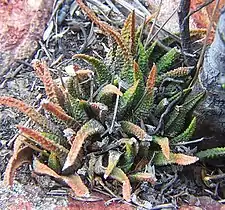Haworthiopsis scabra
Haworthiopsis scabra, formerly Haworthia scabra, is a species of flowering succulent plant from arid regions of the Western and Eastern Cape Provinces, South Africa.
| Haworthiopsis scabra | |
|---|---|
 | |
| Haworthiopsis scabra var. scabra in cultivation | |
| Scientific classification | |
| Kingdom: | Plantae |
| Clade: | Tracheophytes |
| Clade: | Angiosperms |
| Clade: | Monocots |
| Order: | Asparagales |
| Family: | Asphodelaceae |
| Subfamily: | Asphodeloideae |
| Tribe: | Aloeae |
| Genus: | Haworthiopsis |
| Species: | H. scabra |
| Binomial name | |
| Haworthiopsis scabra (Haw.) G.D.Rowley[1] | |
| Synonyms[1] | |
| |
Description
Haworthiopsis scabra is a very variable species, with several very distinct varieties. Its name "scabra" means "rough", but only its type-variety truly has rough leaves. It typically grows its leaves in three tiers (trifarious) though some varieties have five-tier leaf arrangement. Many varieties have a spiral twist to their leaves.
Varieties
- H. s. var. scabra (Haw.) The widespread type-variety; dark and rough from dense tubercles
- H. s. var. plettens (Bayer) Rough surface (small tubercles)
- H. s. var. starkiana (Poelln.) Smooth variety, light coloured and without tubercles
- H. s. var. lateganiae (Poelln.) Larger, smooth, offsetting variety with long, thin leaves
- H. s. var. smitii A variety from the Small Karoo (South Africa), with few large tubercles and raised margins and keels
- H. s. var. morrisiae (Poelln.) Intermediate, banded variety with confluent tubercles
- H. s. var. johanii (Breuer, Hayashi) Long-leaved offsetting variety
The flowers typically appear in November and December.
 Haworthiopsis scabra var. scabra; the type form in habitat
Haworthiopsis scabra var. scabra; the type form in habitat Haworthiopsis scabra var. starkiana – sometimes classed as a separate species Haworthiopsis starkiana
Haworthiopsis scabra var. starkiana – sometimes classed as a separate species Haworthiopsis starkiana Haworthiopsis scabra var. plettens – the small tubercled variety in habitat near Plettenberg Bay
Haworthiopsis scabra var. plettens – the small tubercled variety in habitat near Plettenberg Bay Young Haworthiopsis scabra var. smitii in cultivation
Young Haworthiopsis scabra var. smitii in cultivation Seedlings of Haworthiopsis scabra var. lateganiae
Seedlings of Haworthiopsis scabra var. lateganiae
Taxonomy
The species was previously including in Haworthia subgenus Hexangulares. Phylogenetic studies demonstrated that subgenus Hexangulares was actually relatively unrelated to other haworthias and so it was moved to the new genus Haworthiopsis.[2][3]
Distribution
This species extends across the southern part of South Africa in the arid Little Karoo region. Here it grows on both sides of the border between the Western and Eastern Cape Provinces, from Ladismith in the West to Baviaanskloof in the East.
Within this range, it typically grows in very well-drained sandy soil, usually under a bush or rocks which serve as partial protection from the sun.
Cultivation
It is very slow growing and is not common in cultivation. It requires extremely well-drained soil and minimal water. They thrive in shady conditions, though some varieties such as starkiana can be adjusted gradually to full sun.
References
- "Haworthiopsis scabra", World Checklist of Selected Plant Families, Royal Botanic Gardens, Kew, retrieved 2017-10-16
- Manning, John; Boatwright, James S.; Daru, Barnabas H.; Maurin, Olivier; van der Bank, Michelle. A Molecular Phylogeny and Generic Classification of Asphodelaceae subfamily Alooideae: A Final Resolution of the Prickly Issue of Polyphyly in the Alooids? Systematic Botany, Volume 39, Number 1, March 2014, pp. 55-74
- "All about Haworthia".